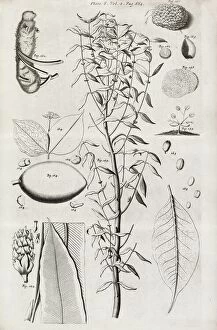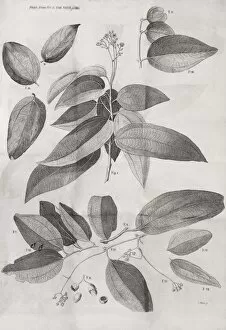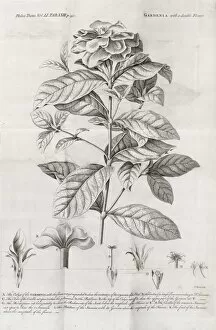Flowering Parts Collection
"Exploring the Beauty of Flowering Parts: Botanical Illustrations from the 17th and 18th Century" Step back in time with these stunning botanical illustrations
For sale as Licensed Images
Choose your image, Select your licence and Download the media
"Exploring the Beauty of Flowering Parts: Botanical Illustrations from the 17th and 18th Century" Step back in time with these stunning botanical illustrations, capturing the intricate details that have fascinated scientists and artists for centuries. In the 17th century, a cinnamon plant illustration mesmerized viewers with its delicate blossoms and aromatic allure. The artist's meticulous brushstrokes brought to life each petal, stamen, and pistil. Moving forward to the 18th century, another masterpiece emerged - a gardenia plant illustration. Its velvety white petals seemed almost tangible on paper, while its intoxicating fragrance wafted through pages. But not all flowers are gentle beauties; some possess hidden dangers. Take the stinging nettle for example - an image revealing its tiny yet potent spines under a light micrograph. A reminder that nature's beauty can sometimes come with a sting. Speaking of intriguing structures, let us delve into the arum plant spadix captured under a light micrograph once again. Its peculiar shape evokes curiosity as we marvel at this unique adaptation designed to attract pollinators. Shifting our focus to field pennycress flowers seen through scanning electron microscopy (SEM), we witness their intricate patterns up close. Each minuscule detail is magnified, unveiling nature's artistry in even the tiniest blooms. And who could forget about marigold? An enchanting flower whose vibrant colors burst forth in this captivating light micrograph. It reminds us that even amidst chaos and darkness, there is always room for brightness and joy. Finally, we encounter passion flower (Passiflora amethystina) – an exotic wonder repeated three times over. These ethereal blooms captivate our senses with their intricate layers of petals and filaments dancing harmoniously together. These glimpses into past eras remind us of humanity's enduring fascination with the flowering parts of nature.






